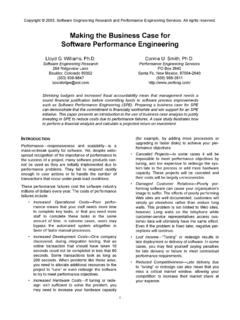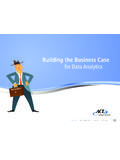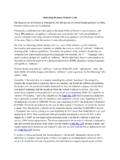Transcription of Business Modeling with UML - UTM
1 Business Modeling with UML Hans-Erik Eriksson and Magnus Penker, Open Training Hans-Erik Ericsson is found and Chairman of Open Training Magnus Penker is CEO of Open Training. In order to keep up and be competitive, all companies and enterprises must assess the quality of their products and the efficiency of their services. In doing so, they must consider what is happening in the world around them, and they must also take an introspective look at their products or services. Is their internal operation working smoothly? Can they improve their product or service? Is their production running as efficiently as possible? Can they expand their product or service portfolios to reach new markets and customers? In addition to products and services, today's businesses must also evaluate their information systems. Do the information systems effectively support their way of working? Do the systems adapt easily to change? Is information used as an important strategic resource in the Business ?
2 Is the information adequate and correct? In many of today's businesses, information systems no longer merely support the Business . Increasingly, they are becoming an integral part of it. All businesses make some use of information technology, and it is important that their systems are really built to support the businesses of which they are an integrated part. The Business is what ultimately defines the requirements on the information systems, and creating software without a proper understanding of the context in which that software is to operate is a dangerous adventure. In order to get such an understanding, it is essential to make a model of the Business . A model is a simplified view of a complex reality. It is a means to creating abstraction, allowing you to eliminate irrelevant details and focus on one or more important aspects at a time. Effective models also facilitate discussions among different stakeholders in the Business , allowing them to agree on the key fundamentals and to work towards common goals.
3 Finally, a Business model can be the basis for other models, such as models for different information systems that support the Business . Modeling ( , with UML) has been accepted and established as a means of analyzing and designing software. In order to create the best software, the businesses in which the software systems operate must also be modeled, understood, and sometimes improved. The Business model is the center for conducting Business or improving how the Business is operated. The evolving models also help the developers structure and focus their thinking. Working with the models increases their understanding of the Business and, hopefully, also their awareness of new opportunities for improving Business . Many development processes that use UML advocate that the system development should start with use case Modeling to define the functional requirements on the system. A use case describes a specific usage of the system by one or more actors.
4 An actor is a role that a user or another system has. The objective of use case Modeling is to identify and describe all the use cases that the actors require from the system. The use case descriptions then are used to analyze and design a robust system architecture that realizes the use cases (this is what is referred to as "use case driven" development). But how do you know that all of the use cases, or even the correct use cases that best support the Business in which the system operates, are identified? To answer such questions you need to model and understand the system's surroundings. Modeling a Business 's surroundings involves answering such questions as: How do the different actors interact? What activities are part of their work? What are the ultimate goals of their work? What other people, systems, or resources are involved that do not show up as actors to this specific system? What rules govern their activities and structures?
5 Are there ways actors could perform more efficiently? The answers to these questions come from tackling the entire Business and looking beyond the functions of the information system currently being built (and using techniques other than use case Modeling ). The ultimate objective of all software systems is to give correct and extensive support to the Business of which it is a part. However, when Modeling the surroundings of the information system, you are no longer Modeling software. Enter the world of Business Modeling . There can be many reasons for doing Business Modeling : To better understand the key mechanisms of an existing Business . The models can be used to train people by providing a clear picture of their role and tasks in the overall organization. To act as the basis for creating suitable information systems that support the Business . The descriptions of the Business are used to identify necessary information system support.
6 The models are also used as a basis for specifying the key requirements on those systems. Ideally large parts of the Business model can be mapped directly onto software objects. As more and more infrastructure software systems are bought, there is a potential for the systems that are developed to become more Business driven where the developers can concentrate more on functionality that supports the Business rather than solving technical incompatibilities or problems. To act as the basis for improving the current Business structure and operation. The models identify changes in the current Business that are necessary to implement the improved Business model. To show the structure of an innovated Business . The model becomes the basis for the action plan. Innovation suggests that radical change, rather than incremental changes, have been made to the Business processes. To experiment with a new Business concept, or to copy or study a concept used by a competitive company ( , benchmarking on the model level).
7 The developed model becomes a sketch of a possible development for the Business . The model can be a new idea, inspired by Modeling other businesses, or taking advantage of new technologies, such as the Internet. To identify outsourcing opportunities. Parts of the Business that are not considered the "core Business " are delegated to outside suppliers. The models are used as the specification for the suppliers. Business Modeling with UML UML has quickly been adopted as the standard Modeling language for Modeling software systems. This article (and the book from which it is an extract) discusses how UML also can be used for Business Modeling and thus demonstrate that the same Modeling language can be used for the Business models as for the software models. UML was defined to model the architecture of software systems. Even though there are similarities between software and Business systems, there are also some differences. Business systems have many concepts that are never intended or suitable to execute in a program, such as the people working in the Business , manufacturing production equipment, and rules and goals that drive the Business processes.
8 UML was initially designed to describe aspects of a software system. Because of this, UML needed to be extended in order to more clearly identify and visualize the important concepts of processes, goals, resources, and rules of a Business system. To address this issue, we have created a set of extensions based on the existing model elements of UML. These extensions are called Eriksson-Penker Business Extensions and provide symbols for Modeling the processes, resources, rules, and goals of a Business system. These extensions form a basic framework for Business extensions to UML (rather than a definitive set of Business extensions) to which a Business architect can add stereotypes or properties suitable to his or her line of Business . The standard extension mechanisms in UML that allow you to adapt UML to accommodate new concepts are: Stereotypes. An extension of the vocabulary of the UML, which allows you to create new building blocks from existing ones but specific to your problem [Booch, 1998].
9 Stereotypes may have their own visual icons that replace the icon which the existing UML element uses. Tagged values (properties). An extension of the properties of a UML element, which allows you to create new information in that element's specification [Booch,1998]. Constraints. An extension of the semantics of a UML element, allowing you to add new rules or modify existing ones [Booch, 1998]. Although different businesses have different goals and internal structures they use similar concepts to describe their structure and operation, and it is to represent these concepts the extension mechanisms in UML have been used for this purpose. The primary concepts used when defining the Business system are (a complete meta-model describing these concepts and their relationships is available in the book): Resources. The objects within the Business , such as people, material, information, and products, that are used or produced in the Business .
10 The resources are arranged in structures and have relationships with each other. Resources are manipulated (used, consumed, refined, or produced) through processes. Resources can be categorized into physical, abstract, and informational (each having their own stereotype). Processes. The activities performed within the Business in which the state of Business resources changes. Processes describe how the work is done within the Business . Processes are governed by rules. Goals. The purpose of the Business , or the outcome the Business as a whole is trying to achieve. Goals can be broken down into sub-goals and allocated to individual parts of the Business , such as processes or objects. Goals express the desired states of resources and are achieved by processes. Goals can be expressed as one or more rules. Rules. A statement that defines or constrains some aspect of the Business , and represents Business knowledge. It governs how the Business should be run ( , how the processes should execute) or how resources may be structured and related to each other.













